Твердосплавные пластины для инструментов являются важнейшими компонентами современных процессов обработки и металлообработки. Они обеспечивают превосходные характеристики резания, долговечность и универсальность, что делает их незаменимыми в различных областях промышленности. В этом подробном руководстве мы расскажем обо всем, что вам нужно знать о твердосплавных пластинах, включая их типы, области применения, свойства материалов и то, как выбрать подходящую для ваших нужд.
Обзор твердосплавных инструментальных пластин
Твердосплавные вставки - это сменные наконечники, используемые в механической обработке для резки, придания формы и отделки материалов. Они изготавливаются из карбида - композитного материала, состоящего из частиц карбида вольфрама, скрепленных металлом, обычно кобальтом. Такое сочетание придает твердосплавным пластинам известную твердость и долговечность. Они используются в токарных, фрезерных и сверлильных операциях в различных отраслях промышленности, от автомобильной до аэрокосмической.
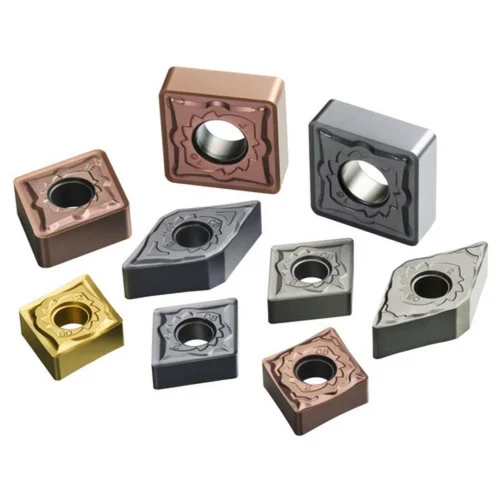
Типы Твердосплавные инструментальные вставки
Твердосплавные пластины для инструментов бывают разных форм, размеров и составов, каждый из которых подходит для выполнения определенных задач и работы с конкретными материалами. Вот таблица, в которой представлены различные типы твердосплавных вставок:
| Тип вставки | Форма | Типовые применения |
|---|---|---|
| CNMG | Алмаз | Токарные, торцовочные и отделочные работы |
| TNMG | Треугольник | Средняя и тяжелая резка, общее назначение |
| SNMG | Квадрат | Черновая обработка, прерывистая резка, тяжелые условия эксплуатации |
| VNMG | V-образный | Финишная обработка, профилирование и высокоточные работы |
| WNMG | Шестигранник | Черновая и прерывистая резка средней и большой толщины |
| CCMT | Алмаз | Легкая и средняя резка, высокая точность и чистовая обработка |
| DCMT | Алмаз | Финишная обработка и легкая резка |
| SCMT | Квадрат | Средний для черновой обработки, прерывистой резки и тяжелых условий эксплуатации |
| RCMT | Круглый | Легкое и среднее точение, профилирование и высокоскоростная резка |
| APKT | Прямоугольная | Фрезерные работы, высокие скорости подачи и тяжелые условия эксплуатации |
Области применения твердосплавных инструментальных пластин
Универсальность твердосплавных пластин позволяет использовать их в самых разных областях. Вот таблица, в которой представлены области применения твердосплавных пластин:
| Промышленность | Приложение |
|---|---|
| Автомобильная промышленность | Компоненты двигателя, детали трансмиссии, системы подвески |
| Аэрокосмическая промышленность | Лопасти турбин, шасси, структурные компоненты |
| Медицина | Хирургические инструменты, имплантаты, протезы |
| Нефть и газ | Буровые долота, обсадные трубы, скважинные инструменты |
| Производство | Общая механическая обработка, изготовление инструментов и штампов, производство пресс-форм |
| Электроника | Микрообработка, производство печатных плат, полупроводниковых приборов |
Свойства материалов твердосплавных инструментальных пластин
Понимание свойств материалов твердосплавных пластин необходимо для выбора подходящей пластины для вашего применения. Вот таблица, в которой представлены свойства материалов:
| Недвижимость | Описание |
|---|---|
| Твердость | Высокая устойчивость к износу и деформации, обычно измеряемая по шкале Роквелла или Виккерса |
| Жесткость | Способность поглощать энергию и противостоять сколам и разрушениям |
| Термостойкость | Сохраняет твердость и прочность при повышенных температурах |
| Химическая устойчивость | Устойчивость к коррозии и химическим реакциям с рабочими материалами |
| Теплопроводность | Эффективно отводит тепло, выделяемое при резке |

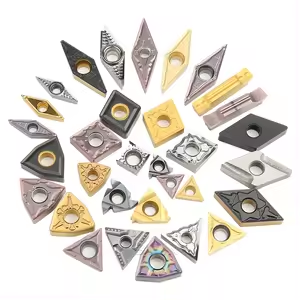
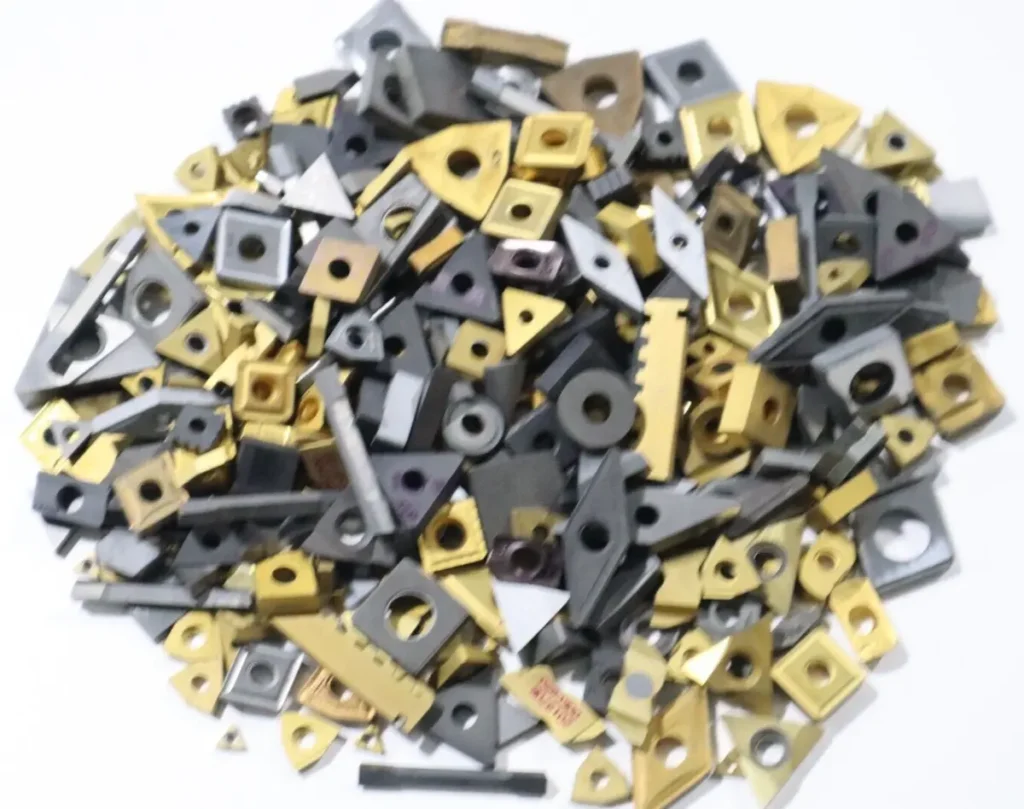
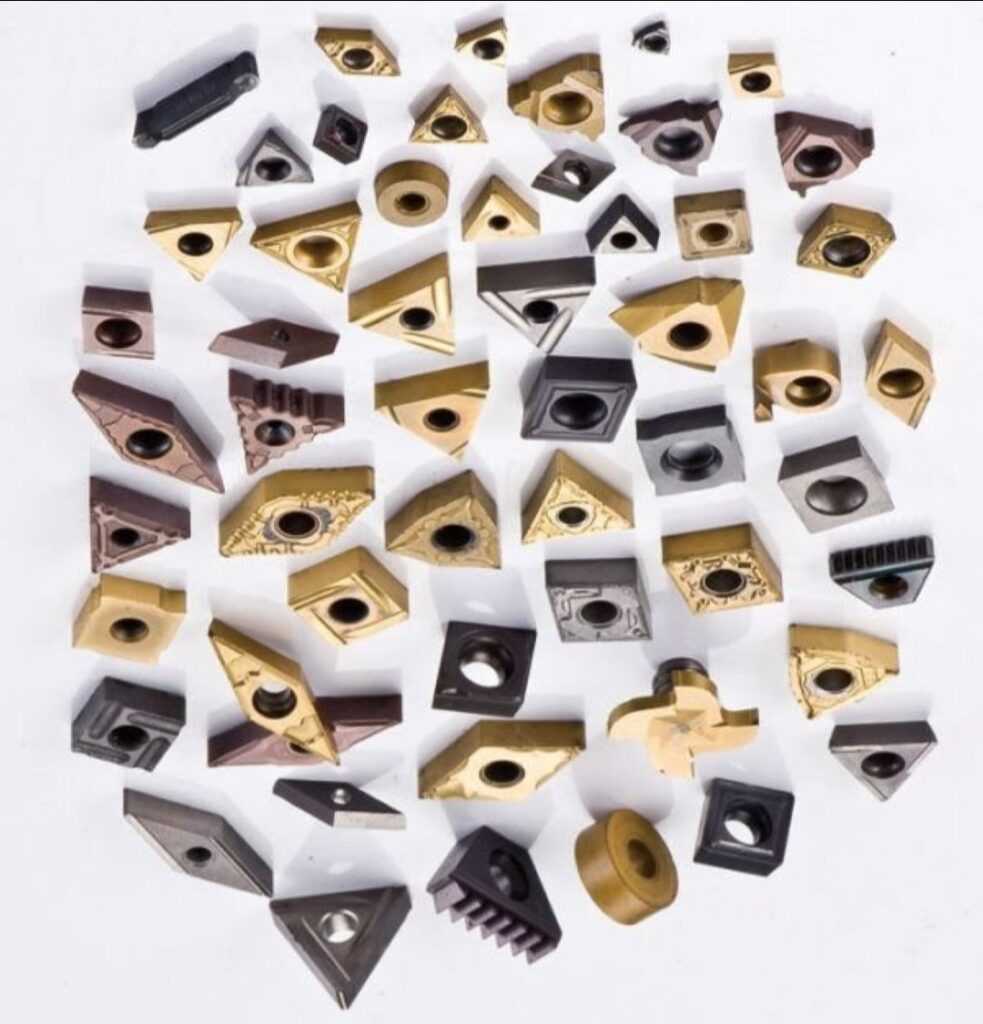
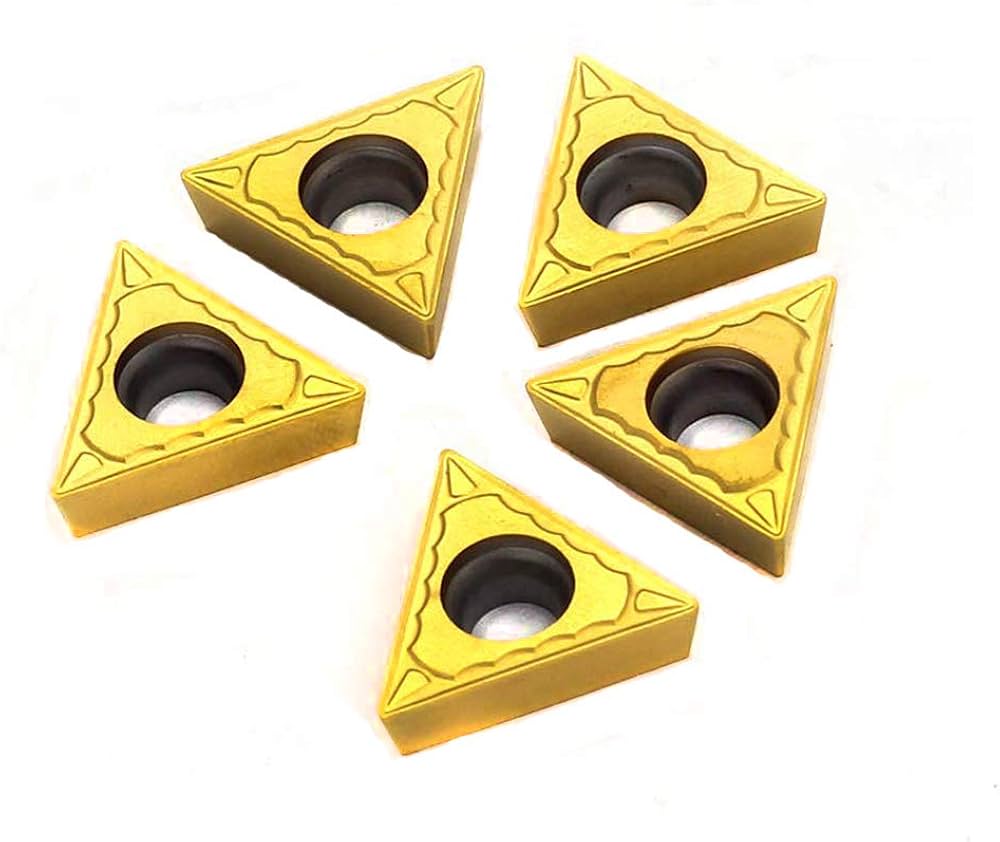

Состав и характеристики Твердосплавные инструментальные вставки
Твердосплавные пластины для инструментов изготавливаются из различных сортов твердого сплава, каждый из которых обладает уникальными характеристиками. Вот таблица, в которой представлены состав, свойства, характеристики и т. д:
| Класс | Состав | Характеристики |
|---|---|---|
| C1 | 97% WC, 3% Co | Высокая износостойкость, используется для цветных материалов |
| C2 | 94% WC, 6% Co | Универсальный, подходит для черных и цветных материалов |
| C3 | 90% WC, 10% Co | Повышенная прочность, используется для прерывистых резов |
| C4 | 86% WC, 14% Co | Очень прочный, подходит для тяжелых условий эксплуатации |
| C5 | 81% WC, 19% Co | Высочайшая прочность, используется для очень тяжелых условий эксплуатации |
| P10 | 92% WC, 8% Co, добавки TiC/TaC | Хорошо подходит для высокоскоростной обработки стали |
| P20 | 89% WC, 11% Co, добавки TiC/TaC | Токарная и фрезерная обработка стали общего назначения |
| P30 | 85% WC, 15% Co, добавки TiC/TaC | Черновая и прерывистая резка в стали |
| K10 | 94% WC, 6% Co, добавки Cr3C2/TaC | Отделка и полуотделка чугуна |
| K20 | 90% WC, 10% Co, добавки Cr3C2/TaC | Черновая обработка чугуна и цветных металлов |
Твердость, прочность и износостойкость
Вот таблица, показывающая твердость, прочность и износостойкость твердосплавных пластин:
| Класс | Твердость (HV) | Жесткость (МПа) | Износостойкость |
|---|---|---|---|
| C1 | 1800 | 1200 | Очень высокий |
| C2 | 1600 | 1500 | Высокая |
| C3 | 1500 | 1800 | Средний |
| C4 | 1400 | 2200 | Средний |
| C5 | 1300 | 2500 | Низкий |
| P10 | 1700 | 1400 | Высокая |
| P20 | 1600 | 1600 | Средний |
| P30 | 1500 | 2000 | Низкий |
| K10 | 1650 | 1300 | Высокая |
| K20 | 1500 | 1800 | Средний |
Технические характеристики, размеры, форма, стандарты
Твердосплавные вставки для инструментов доступны в различных спецификациях, размерах и формах. Вот таблица, показывающая спецификации, размеры, форму, стандарты:
| Форма | Размер (мм) | Толщина (мм) | Стандарт ISO | Стандарт ANSI |
|---|---|---|---|---|
| Треугольник | 12, 16, 20 | 3.97, 4.76, 6.35 | ISO 1832 | ANSI B212.4 |
| Алмаз | 11, 13, 16 | 2.38, 3.18, 4.76 | ISO 1832 | ANSI B212.4 |
| Квадрат | 12, 16, 20 | 3.97, 4.76, 6.35 | ISO 1832 | ANSI B212.4 |
| Круглый | 16, 20, 25 | 4.76, 6.35, 9.53 | ISO 1832 | ANSI B212.4 |
| Прямоугольная | 10, 15, 20 | 2.38, 3.97, 4.76 | ISO 1832 | ANSI B212.4 |
Поставщики и ценовая политика
Выбор правильного поставщика имеет решающее значение для обеспечения качества и производительности твердосплавных пластин. Вот таблица с поставщиками и ценовой информацией:
| Поставщик | Расположение | Диапазон цен (USD) | Связаться с |
|---|---|---|---|
| Kennametal | США | 10-50 за вставку | www.kennametal.com |
| Sandvik Coromant | Швеция | 15-60 за вставку | www.sandvik.coromant.com |
| Искар | Израиль | 12-55 на вставку | www.iscar.com |
| Инструменты Seco | Швеция | 13-58 на вставку | www.secotools.com |
| Mitsubishi | Япония | 14-60 на вставку | www.mitsubishicarbide.com |
| Kyocera | Япония | 10-45 за вставку | www.kyocera.com |
| Sumitomo | Япония | 11-50 на вставку | www.sumitomotool.com |
| Инструменты Walter | Германия | 13-55 за вставку | www.walter-tools.com |
| Tungaloy | Япония | 12-54 на вставку | www.tungaloy.com |
| Ceratizit | Люксембург | 15-60 за вставку | www.ceratizit.com |
Как выбрать правильный Твердосплавные инструментальные вставки
Выбор подходящей твердосплавной пластины предполагает учет нескольких факторов, включая обрабатываемый материал, тип обработки и специфические требования к заданию. Вот таблица, показывающая, как правильно выбрать твердосплавные пластины:
| Фактор | Соображения |
|---|---|
| Обрабатываемый материал | Твердость, прочность и абразивность материала |
| Тип операции | Токарная обработка, фрезерование, сверление, чистовая и черновая обработка |
| Скорость резки | Для высоких скоростей требуются вставки с повышенной термостойкостью |
| Скорость подачи | Для более высоких скоростей подачи могут потребоваться более жесткие пластины |
| Глубина среза | Для глубоких резов могут потребоваться пластины с повышенной прочностью |
| Возможности станков | Мощность, жесткость и скорость станка |
| Требуется отделка поверхности | Для финишной обработки могут потребоваться пластины с более мелкой структурой зерна |
| Ожидаемый срок службы инструмента | Более длительный срок службы инструмента может оправдать более высокую первоначальную стоимость |
Сравнение преимуществ и недостатков Твердосплавные инструментальные вставки
Вот таблица, в которой сравниваются преимущества и недостатки твердосплавных пластин:
| Преимущества | Ограничения |
|---|---|
| Высокая твердость | Может быть хрупкой, подвержена сколам |
| Отличная износостойкость | Более высокая стоимость по сравнению с быстрорежущей сталью (HSS) |
| Способность поддерживать передовые технологии | Ограниченная прочность по сравнению с керамикой |
| Высокая скорость резки | Требует точного обращения и настройки |
| Универсальность применения | Специализированные вставки, необходимые для выполнения конкретных задач |

ЧАСТО ЗАДАВАЕМЫЕ ВОПРОСЫ
Для чего используются твердосплавные пластины?
Твердосплавные пластины используются для резки, формообразования и чистовой обработки различных материалов при таких операциях механической обработки, как точение, фрезерование и сверление.
Почему твердосплавные вставки предпочтительнее инструментов из быстрорежущей стали?
Твердосплавные пластины предпочтительнее, поскольку они обладают повышенной твердостью, износостойкостью и способностью сохранять производительность резания при более высоких скоростях и температурах по сравнению с инструментами из быстрорежущей стали (HSS).
Как выбрать подходящую твердосплавную вставку для моей задачи?
При выборе подходящей твердосплавной пластины следует учитывать обрабатываемый материал, тип обработки, скорость резания, скорость подачи и требуемую чистоту поверхности. Для получения подробных рекомендаций обратитесь к таблице выбора, представленной выше.
Какие существуют различные марки твердосплавных пластин?
Твердосплавные пластины выпускаются различных марок, каждая из которых предназначена для решения конкретных задач. Например, C1 обладает высокой износостойкостью для цветных материалов, а P20 - универсальная марка для точения и фрезерования стали.
Можно ли перетачивать твердосплавные пластины?
В большинстве случаев твердосплавные пластины не затачиваются. Вместо этого их заменяют после износа или повреждения, поскольку повторная заточка может нарушить точность и производительность.
Каков срок службы твердосплавных пластин?
Срок службы твердосплавных пластин зависит от таких факторов, как обрабатываемый материал, условия резания и тип операции. Правильный выбор и использование могут максимально продлить срок их службы.
Каковы преимущества использования твердосплавных пластин с покрытием?
Твердосплавные пластины с покрытием обладают дополнительными преимуществами, включая повышенную износостойкость, снижение трения и увеличение срока службы инструмента, особенно в высокоскоростных и высокотемпературных областях применения.
Где можно купить твердосплавные пластины для инструментов?
Твердосплавные пластины для инструментов можно приобрести у различных поставщиков, таких как Kennametal, Sandvik Coromant, Iscar, Seco Tools и многих других. Более подробную информацию см. в таблице поставщиков.
Существуют ли различные формы твердосплавных вставок?
Да, твердосплавные пластины бывают разных форм: треугольные, алмазные, квадратные, круглые и прямоугольные, каждая из которых подходит для определенных задач и применений.
Каков диапазон цен на твердосплавные пластины?
Стоимость твердосплавных вставок зависит от поставщика, марки и конкретного типа. Обычно цены варьируются от $10 до $60 за вставку. Подробную информацию см. в таблице цен поставщиков.
В заключение следует отметить, что твердосплавные пластины необходимы для эффективной и точной обработки. Понимая их типы, применение, свойства и то, как выбрать подходящую вставку, вы сможете оптимизировать процессы обработки и добиться превосходных результатов.




